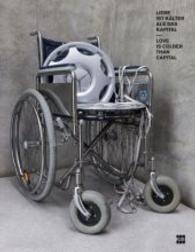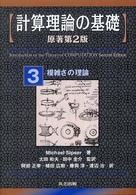- ホーム
- > 洋書
- > 英文書
- > Science / Mathematics
基本説明
Covers structure and defect analysis, modelling and simulation and apparel design, and more.
Full Description
Computer technology has transformed textiles from their design through to their manufacture and has contributed to significant advances in the textile industry. Computer technology for textiles and apparel provides an overview of these innovative developments for a wide range of applications, covering topics including structure and defect analysis, modelling and simulation, and apparel design.The book is divided into three parts. Part one provides a review of different computer-based technologies suitable for textile materials, and includes chapters on computer technology for yarn and fabric structure analysis, defect analysis and measurement. Chapters in part two discuss modelling and simulation principles of fibres, yarns, textiles and garments, while part three concludes with a review of computer-based technologies specific to apparel and apparel design, with themes ranging from 3D body scanning to the teaching of computer-aided design to fashion students.With its distinguished editor and international team of expert contributors, Computer technology for textiles and apparel is an invaluable tool for a wide range of people involved in the textile industry, from designers and manufacturers to fibre scientists and quality inspectors.
Contents
Contributor contact detailsWoodhead Publishing Series in TextilesIntroductionPart I: Computer-based technology for textile materialsChapter 1: Digital technology for yarn structure and appearance analysisAbstract:1.1 Introduction1.2 Measurement of yarn evenness1.3 Analysis of yarn hairiness1.4 Measurement of yarn twist1.5 Recognition of yarn snarl1.6 Analysis of yarn blend1.7 Grading of yarn appearance1.8 Future trends1.9 Conclusions1.10 AcknowledgementChapter 2: Digital-based technology for fabric structure analysisAbstract:2.1 Introduction2.2 Background and literature review2.3 The digital system for weave pattern recognition2.4 Theoretical background for weave pattern analysis2.5 Methodology for active grid model (AGM) construction and weave pattern extraction2.6 ConclusionsChapter 3: Computer vision-based fabric defect analysis and measurementAbstract:3.1 Introduction3.2 Fabric inspection for quality assurance3.3 Fabric defect detection methods3.4 Fabric defect classification3.5 Fabric properties and color measurement using image analysis3.6 Conclusions and future trends3.7 AcknowledgmentsPart II: Modelling and simulation of textiles and garmentsChapter 4: Key techniques for 3D garment designAbstract:4.1 Introduction4.2 Sketch-based garment design4.3 Surface flattening for virtual garments4.4 Online garment-shopping system: problems and solutions4.5 Challenges and future trends4.6 Sources of further informationChapter 5: Modelling and simulation of fibrous yarn materialsAbstract:5.1 Introduction5.2 Modelling and simulation of yarns5.3 Weave modelling5.4 Geometrical modelling of woven fabrics5.5 Finite element (FE) modelling of woven fabrics5.6 Future development of textile modelling5.7 AcknowledgementsChapter 6: Digital technology and modeling for fabric structuresAbstract:6.1 Introduction6.2 Background on woven fabric structure6.3 Fabric geometry structure models6.4 Fabric weave pattern6.5 Description and classification of regular patterns6.6 Description and classification of irregular patterns6.7 Weave pattern and fabric geometry surface appearance6.8 Experimental pattern analysis6.9 Methodology6.10 Results and discussion6.11 AcknowledgmentChapter 7: Modeling ballistic impact on textile materialsAbstract:7.1 Introduction7.2 Computational aspects7.3 Numerical modeling of single and multiple layer fabric7.4 ConclusionsChapter 8: Modeling and simulation techniques for garmentsAbstract:8.1 Introduction8.2 Model development8.3 Computer graphics techniques for garment structure and appearance8.4 Rendering of garment appearance and model demonstration for garments8.5 Considerations for real-time applications8.6 Advanced modeling techniques8.7 Future developments in simulating garment materials8.8 Conclusions and sources of further information and advicePart III: Computer-based technology for apparelChapter 9: Human interaction with computers and its use in the textile apparel industryAbstract:9.1 Introduction9.2 Principles of human computer interaction (HCI)9.3 Methods for improving human interaction with computers for textile purposes9.4 Future trends9.5 Conclusions9.6 AcknowledgmentChapter 10: 3D body scanning: Generation Y body perception and virtual visualizationAbstract:10.1 Introduction10.2 Literature review10.3 Methodology10.4 Results and findings10.5 Conclusions and recommendations10.6 Limitations10.7 Future studiesChapter 11: Computer technology from a textile designeraEURO (TM)s perspectiveAbstract:11.1 Introduction11.2 Role of computer technology in textile design11.3 Main computer technologies in textile design11.4 Benefits and limitations of computers for textile design11.5 Future trendsChapter 12: Digital printing technology for textiles and apparelAbstract:12.1 Introduction12.2 Review of digital printing technology12.3 Global developments in digital printing technology12.4 Colour technology and colour management12.5 Three stages of computing for digital printing12.6 Future trends12.7 Conclusions12.9 AcknowledgementsChapter 13: Approaches to teaching computer-aided design (CAD) to fashion and textiles studentsAbstract:13.1 Introduction13.2 Review of approaches to teaching computer-aided design (CAD)13.3 Challenges presented by each approach13.4 Case study13.5 Areas for improvement in teaching computer-aided design (CAD)13.6 ConclusionsChapter 14: Three-dimensional (3D) technologies for apparel and textile designAbstract:14.1 Introduction14.2 Applications of three-dimensional (3D) human body modeling14.3 Technologies of human body modeling in three dimensions (3D)14.4 Development of the body surface14.5 Animation14.6 Generic vs individualized body models14.7 Virtual try-on technologies14.8 ConclusionsChapter 15: Integrated digital processes for design and development of apparelAbstract:15.1 Introduction15.2 Conventional design, development and production processes for apparel15.3 Simultaneous design of textile and garment utilizing digital technology15.4 Integrated processes in practice15.5 Role of computer-aided design (CAD) and visualization technologies in integrated textile product design15.6 The future of integrated digital apparel design and development processes15.7 Conclusions15.8 Sources of further informationIndex








